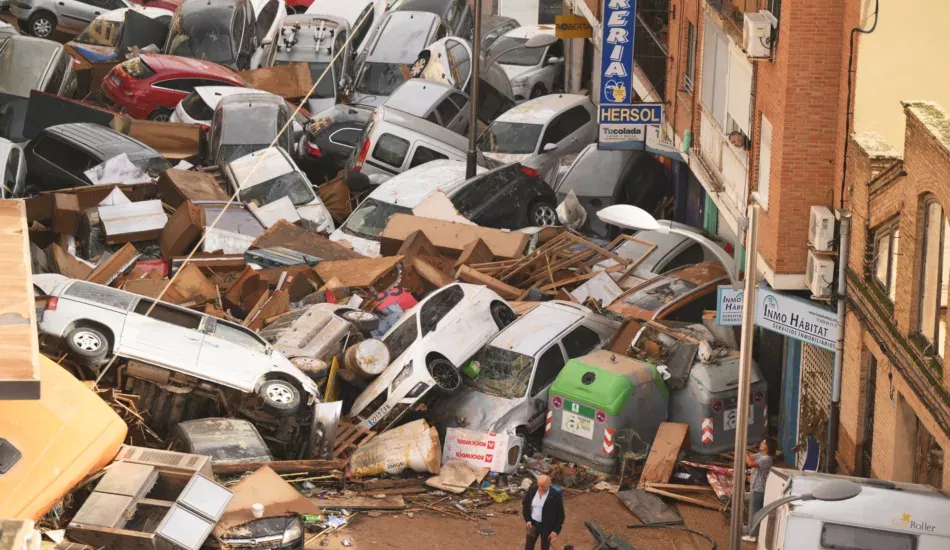World Weather Attribution, an organization that examines the link between climate change and extreme weather events, looks back over the past 20 years. What can be learned from the 10 biggest natural disasters during that time? Change Inc. lists the five main conclusions.

For proof that climate change is no longer a pipe dream, but is already taking hold, one need not look far beyond the border. Painful images of mourning Spaniards and households standing idly by as their devastated homes are scooped up tell the whole story. In the Valencia region, floods caused massive damage and more than 200 people have already died. And the counter is still running, defense minister Margarita Robles let us know.
The more weighty the report that World Weather Attribution (WWA) published yesterday. The WWA is a global alliance of researchers from various institutions, such as the Dutch KNMI, whose research explores the link between climate change and extreme weather. In "honor" of the WWA's tenth anniversary, the organization looks back at the past 20 years. What can we learn from extreme weather events over that time?
#1: Climate change is making extreme weather events more frequent and intense
.Wranglingly few still frown at this conclusion. Yet it is as important as ever. As climate studies have improved over the years, it is increasingly firmly established that climate change is leading to more extreme weather events, including heat waves, heavy rains, hurricanes and drought. Not only is the intensity of extreme weather increasing, but such conditions are simply more common. WWA's analyses show that the 10 deadliest natural disasters since 2004 were even more extreme due to the impact of climate change. The result: at least 570,000 deaths worldwide. And that, the WWA stresses, already at a warming of 1.3 degrees Celsius. At a warming of between 2.6 and 3.1 degrees - as expected according to a recent study by the UN - the damage will be much greater.
#2: Mathematical models often underestimate climate change's impact on extreme weather events
In the past decade, the WWA has conducted some eighty attribution studies. In other words, research on the impact of climate change on extreme weather. The quality of those studies has improved enormously, according to the organization, and the link between the two phenomena can therefore be demonstrated with increasing frequency. Still, data are often missing or the quality of such measurement data is poor, limiting analysis possibilities. It also appears that the models used often underestimate the impact of climate change on extreme weather.
This happens particularly in Europe, the WWA believes. There, it occurred that mathematical models underestimate observed temperatures during heat waves. Since climate is a very complex system that takes a lot of time and knowledge to properly mimic in simulation models, it is not in itself a crazy fact that models sometimes underperform. What is worrying, however, is that this means future damage may be worse than we currently expect.
#3: Climate adaptation, especially in vulnerable areas, is essential to protect human lives
.Of course, it is vital to reduce CO2 emissions as soon as possible to ensure that climate change is slowed down. But, according to the WWA, we must also ensure that society is increasingly equipped to cope with the consequences of climate change, including extreme weather events. That way, instead of having to act after the fact to repair damage, damage can be prevented and lives can be saved. This includes things like heat-resistant buildings, flood dikes, and an agricultural system that can handle prolonged drought. This is especially essential in vulnerable areas, where extreme weather is relatively quick to disrupt.
#4: Climate adaptation is already running into limits in some places
.In some places that are often victims of natural disasters, work is already being done on climate adaptation. But in those places, people are increasingly running up against limits of what is realistic, the WWA believes. For example, some natural disasters were so severe that the researchers wonder: could we reasonably have expected people to be able to do something about them in time? When entire cities are destroyed, including safe zones, is there any conceivable solution at all that could have prevented it? Familiar stumbling blocks, such as piecing together funding, technological feasibility and political support, quickly throw a spanner in the works. Reading between the lines, the WWA wants to warn that we should not let things get so far that there is nothing left to do about adaptation.
#5: We must shift from symptom management to systems thinking
Often natural disasters are treated as incidents. Climate adaptation focuses primarily on one area, such as raising levees against flooding. For the future, this is not a wise approach, the WWA concludes. This is because it is increasingly common for extreme weather events to follow each other in rapid succession (which has more severe consequences than if they were staggered), or even to fuel each other. In the latter case, one natural disaster leads to another, such as a forest fire making an area more susceptible to flooding. The advice is therefore not to act on an incident-by-incident basis, but to take measures that have broader effects. As an example, the WWA cites "rain gardens" that both allow rainwater to drain properly and have a cooling effect on the surrounding area.
Source: Change Inc.